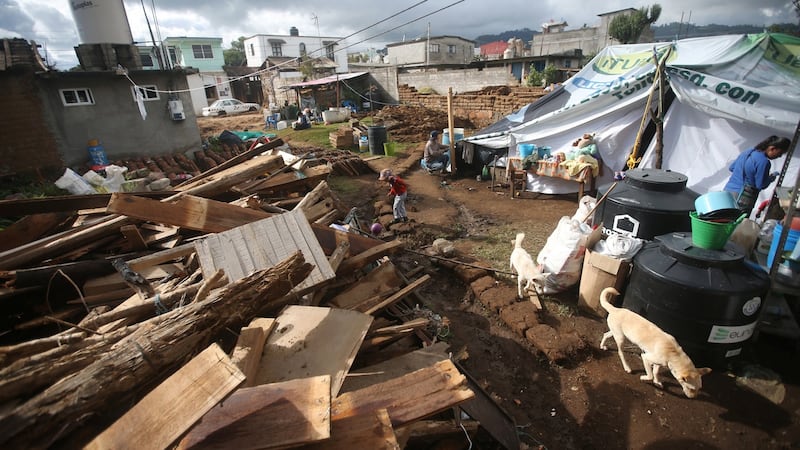A fresh aftershock rattled southwestern Mexico on Sunday as thousands of rescuers toiled for the sixth straight day despite fading hopes of pulling survivors from the ruins of the country's deadliest earthquake in 32 years.
With prospects dimming of finding more people alive in the wreckage of Tuesday's 7.1 magnitude quake, which killed at least 318 people in the Mexico City capital and nearby states, president Enrique Pena Nieto urged Mexicans to turn their attention to rebuilding.
In the sprawling capital of 20 million people, survivors slept in makeshift shelters or on the street outside their damaged homes.
Rescuers using advanced audio equipment to detect signs of life beneath tonnes of rubble narrowed their search to a handful of buildings.
With Mexico facing a presidential election next year, the government’s response to the disaster is under close scrutiny.
Frustration has grown among the thousands left homeless by Tuesday’s quake, with critics saying the government’s reaction pales in comparison with an outpouring of volunteer support, from rescue work to food donations.
“We have received no help from authorities,” said Antonio Ramirez, who was conducting a survey of damaged homes in the historic Xochimilco district in the south of the capital.
“The help has come from ordinary people,” the 57-year-old retired teacher said.
“Soldiers, instead of carrying picks and shovels, brought their guns.”
Hitting back against criticism of his government, president Pena Nieto has visited the scene of the devastation and promised ongoing support to those affected.
Dozens of structures were flattened in Mexico City by Tuesday’s quake, the country’s most deadly since a 1985 tremor killed thousands.
It was the second major earthquake to strike the country of 127 million people this month.
A massive 8.1 magnitude quake on September 7th off the southwestern coast of Mexico killed around 100 people, most of them in the nearby states of Oaxaca and Chiapas. A series of aftershocks since then have sown panic.
The latest tremor, of 5.9 magnitude, struck on Sunday off the west coast, with its epicentre 99 km south-southwest of Tonala, in Chiapas, the Pacific Tsunami Warning Center said. There were no immediate reports of significant damage.
Aftershocks on Saturday spread fear among Mexico’s traumatised population, and a plume of ash spewed from the Popocatepetl volcano in another reminder of the country’s volatile geology.

Many more quakes are likely, warned Xyoli Perez Campos, director of Mexico’s National Seismological Service.
“We have already recorded more than 4,300 aftershocks,” Mr Campos said.
“So more aftershocks are to come. What we don’t know is if they are going to be of significant magnitude.”
‘Life must go on’
In Mexico City, the search for survivors from Tuesday’s quake continued in a ruined office building in the hip Roma neighbourhood and in a five-story apartment building in historic Tlalpan.
Authorities called off efforts in the upper-middle class Linda Vista zone after pulling 10 bodies from the rubble, while work at the Tlalpan building was briefly halted on Saturday by a magnitude 6.2 aftershock.
“In Tlalpan, there is still a possibility of finding people alive. It’s URGENT,” read a meme passed around on Saturday on social networks.
In tents set up in different parts of the city, psychologists offered mental health support to traumatised survivors and rescuers. Acts of solidarity came from all corners of Mexican society.
With an estimated 30 million people living in the area affected by Tuesday’s quake, the temblor may have left economic losses of €3 billion to €7 billion.
Some 30,000 homes were badly damaged in the adjacent states of Morelos and Puebla.
At least 7,000 schools across the country have been damaged. The Mexican government says at least 350 of them need to be completely rebuilt.
In the hard-hit Roma district of Mexico City, 36-year-old Claudia Avila was, like many people, determined to return to some semblance of normality.
“We are afraid, but life must go on,” said Avila, whose sons are aged 9 and 16. “Tomorrow I will take my children back to school. They know that if something happens, they must protect themselves. It has been a rude awakening.”
President Pena Nieto was highlighting his government’s aid for survivors on a Saturday tour of Jiquipilas in Chiapas, which was badly hit by the September 7th quake.
“Be assured that the federal government is here, the state and local governments, supporting you, hand in hand, to rebuild,” he said.
But many Mexicans are wary of politicians’ using the quake to score political points ahead of 2018 elections that are seen as a referendum on the patchy record of the Institutional Revolutionary Party since its return to power in 2012.
Francisco Honoraro, a 46-year-old farmer in Xochimilco, is living on the streets while he waits for authorities to assess damage to his home.
“This is going to become political, a campaign issue and a source of profit,” he said.
“’If you support me and you vote for me, we will help you.’”
Reuters












